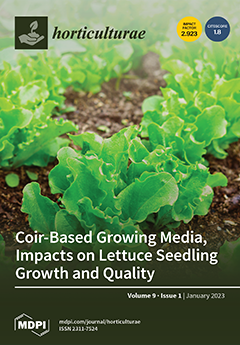Sages are medicinal and aromatic plants that constitute a large pool from which active compounds of great pharmaceutical potential can be derived, while at the same time, they also have ornamental value. The purpose of this study was to develop the micropropagation protocols of
Salvia fruticosa,
S. officinalis,
S. ringens,
S. tomentosa, and
S. pomifera ssp.
pomifera to facilitate their exploitation in the pharmaceutical and floriculture industries. In vitro cultures of
S. ringens and
S. pomifera ssp.
pomifera was studied for the first time. Shoot tips and single node explants from in vitro seedlings were initially cultured on hormone free (Hf)-MS medium, followed by subcultures on MS medium supplemented with 6-benzyladenine (BA) for all species, as well as with zeatin (ZEA), kinetin (KIN), 6-(γ,γ-dimethylallyamino) purine (2iP), or meta-topolin (mT) for
S. fruticosa and
S. officinalis, at concentrations 0.0 to 3.2 mg L
−1, in combination with 0.01 mg L
−1 1-naphthaleneacetic acid (NAA).
S. officinalis was the most efficient in shoot multiplication of all the studied species. The highest multiplication indices were found using 0.8 mg L
−1 BA for
S. fruticosa, 0.4 mg L
−1 BA, or mT for
S. officinalis, and lower than 0.8 mg L
−1 BA for the other three species. Hyperhydricity was a problem at the multiplication stage, and was most pronounced in single node explants, increasing in proportion to cytokinin concentration. Microshoots rooted at high percentages (75–85%) on half-strength MS medium with 0.0 or 0.5 mg L
−1 Indole-3-butyric acid (IBA), except for those of
S. ringens, which rooted best at 1.0–2.0 mg L
−1 IBA. Ex vitro acclimatization was highly successful (80–95%) on peat–perlite substrate (1:1
v/
v). Thus, the present study resulted in efficient micropropagation protocols for five Mediterranean sage species native to Greece, which will facilitate breeding programs and the promotion of these species in the floriculture and pharmaceutical industries.
Full article





